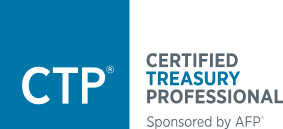CTP Test Specifications
The CTP Examination consists of 170 multiple-choice questions and is based on practical concepts and experiences in relation to treasury management. The exam questions are created by treasury and finance practitioners and updated every three years.
Knowledge Domains and Task Statements
Domain 1: 37-41 questions
Domain 2: 27-31 questions
Domain 3: 27-31 questions
Domain 4: 31-35 questions
Domain 5: 17-20 questions
- Manage optimal cash positioning through short-term investing and borrowing activities
- Forecast/manage cash receipts and disbursements [cash flows]
- Manage optimal banking structure such as cash concentration/pooling etc.
- Manage foreign exchange (FX) exposure
- Manage trade financing (including letters of credit)
- Manage intercompany financing (including loans, repatriation, in-house banking)
- Review cash balances and reconcile transaction activity to ensure accuracy
- Optimize treasury operations (including considerations for roles/responsibilities and outsourcing options)
- Calculate, analyze, and evaluate financial ratios to optimize financial decision making
- Negotiate and manage syndicated agreements
- Manage investment portfolio
- Manage issuance of debt and equity, including post-issuance compliance and retirement
- Manage revolving debt agreements
- Assess impact of mergers, acquisitions, and divestitures
- Evaluate current market conditions (including credit availability, spreads, interest rates, terms, risk) as they relate to long-term borrowing strategies
- Hedge FX, interest rate, and commodities exposure
- Administer dividends, issue or repurchase of stock
Domain 3. Manage internal and external relationships.
- Build, maintain, and review relationships with external financial service providers
- Evaluate and implement treasury products and services (including banking products, treasury workstations)
- Administer bank accounts (including bank fee analysis) and maintain documentation
- Identify, negotiate, and select relationships and operational agreements with external service providers (including financial, technological, and investment/retirement advisors) to ensure best practices and competitive pricing
- Serve as an internal trusted advisor and consultant (including Project Finance)
- Build and maintain relationships with internal stakeholders (including accounting, IT, legal, and tax departments)
- Comply with treasury policies and procedures (such as investment, FX, risk management, hedging, credit approval)
- Draft treasury policies and procedures for approval (such as investment, FX, risk management, hedging, credit approval)
- Detect and mitigate fraud (such as payments, bank transactions, internal, external)
- Benchmark performance against external sources to ensure best practices (including banking fees comparative analysis)
- Evaluate and manage counterparty risk (including risk related to supply chain, banks, brokers, dealers)
- Develop, maintain, and test business continuity plans (including bank balance reporting process, funds transfer capabilities)
- Manage merchant services programs (including fees, risk, controls, card security compliance, retention requirements)
- Ensure regulatory compliance, and report internally and externally on compliance
Domain 5. Assess impact of technologies on the treasury function.
- Leverage technology systems (including enterprise resource planning (ERP) systems and treasury management systems)
- Identify security issues and concerns associated with new and existing technology, including merchant services
- Monitor information security risk and cyber-related risk (including e-mail scams, phishing scams)
33–37% of the questions test knowledge of basic facts and terms.
38–42% of the questions test an understanding of concepts and principles.
23–27% of the questions test the higher thinking ability to apply concepts and principles
to a specific situation.
10–15% of the questions will require mathematical computations.

